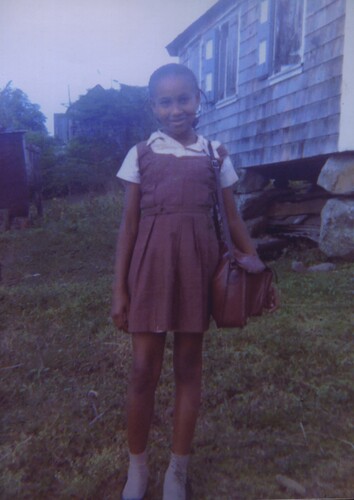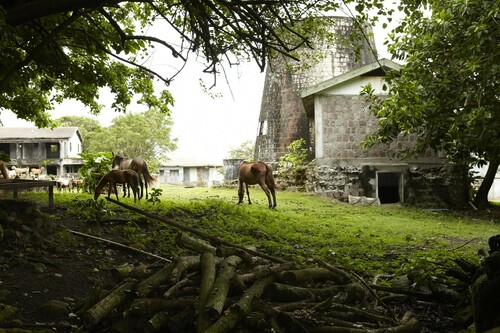Abstract
This interview originated as a series of conversations that took place from May 2019 to January 2021. Focusing on the multimedia artist Stacey Tyrell's photographic series, Chattel (2007–present), the discussion provides an introduction to the origins of the project and outlines the histories and conceptual premise that underlie its making. Reflecting upon the Chattel series' relation to Tyrell's performative projects that challenge notions of Eurocentric beauty and consider conceptions of cultural heritage as capital, Tyrell describes the way that unseen histories and vexed questions of belonging are played out within the genre of landscape photography.
There is a certain impossibility to the act of return. In travelling to a place following a period of absence, the landscape which was once made familiar with repeated presence grows distant through processes of memory and imagination. Arrival, or re-entry, necessitates a temporal overlap where the past and the present fuse, triggering nostalgia, comparison, and recognition of change and loss.
In the artist Stacey Tyrell’s work, this experience is evoked through a photographic process, determined by the lived experience of a specific place, the unknowability of landscapes, and the challenges of documenting home-spaces. Tyrell grew up in Toronto, Canada, to Nevisian parents of Scottish descent, and attended the Ontario College of Art and Design (where she majored in photography). Although she did not grow up within the space she photographs, her work deals with questions of identity, heritage, and spiral-like return in relation to the Caribbean region. The photographic Chattel series – which forms the basis of the conversation presented here – was developed over several trips to the island of her parents’ birth, Nevis. The images within Tyrell’s Chattel series range from photographs of abandoned buildings, to still life, to portraits of family and friends; but the central subject is the Nevisian socio-political context.
Famous as the birthplace of Alexander Hamilton, Nevis is a space with a complex history, frequently determined through movements and exchanges. For over two thousand years prior to colonisation, the island had a large indigenous population who named it Oualie, meaning ‘land of beautiful waters’. In 1493, Columbus sighted the island, and it was subsequently colonised by the Spanish and Dutch, ultimately becoming one of the ‘Crown jewels’ of the British Empire. The Royal African Company brought all its ships through Nevis and the island was one of the most prolific producers of sugar. The landscape was extensively overhauled to create space for cash crops, with humans, animals, machinery, and invasive species brought in to assist with the violently extractive process.
With a population of only 11,000 people, Nevis legally became connected to St Kitts through the federation in 1882 and gained independence in 1983. Since then, tourism has played a large part in shaping the country: a shift that has been made all the more acute by mass immigration and offshore financial services. This switch from the industries of the plantation to tourism and finance has presented increased environmental challenges, as well as an unsettled sense of nationalism.
Tyrell’s most frequently exhibited works involve her dressing up in different guises as a form of self-portraiture in order to challenge preconceived notions of Eurocentric beauty and questions of belonging. This approach has informed a number of distinct yet interconnected series, including Pour La Victoire (2016) and Backra Bluid (2011–2013). The latter draws from words of both West Indian and Scottish origins to explore Tyrell’s heritage and to memorialise the absent presences of ancestors.Footnote1 The large, almost life-sized, confrontational photograph, ‘Mara, 17 yrs.’ (2011) (figure 4), shows the artist disguised with white make-up, a red wig, and photoshopped facial features. She is dressed in a Highland dancing outfit, her arm confidently posed in an angular position with her fist clenched and a challenge in her eye. For Tyrell, the image communicates the discomfort caused when she publicly discusses her Scottish ancestry, due to the implied connection to colonialism and slavery. In performing a Scottish stereotype, the artist conjures up a white alter ego, disguising her multiracial heritage and altering her age, while enacting a direct confrontation of her presence within a narrative of Scottish identity through the stark provocative embodiment of whiteness.Footnote2
FIGURE 1. STACEY TYRELL, ‘MISTRESS KEYS SLAVE PAPAYA’, UNTITLED SERIES, 2018, C-PRINT. COURTESY THE ARTIST.
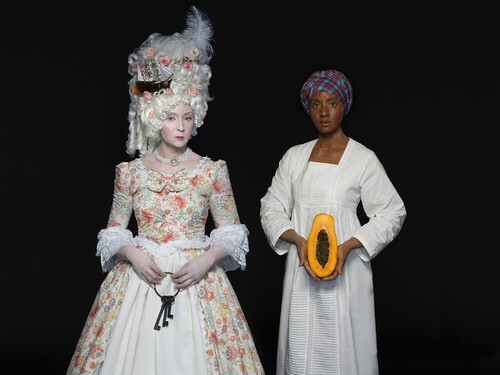
The Chattel series moves the questions of legitimacy and the dominating power of the gaze generated by this self-portrait image into/onto the Nevisian landscape. The project interrogates how the politics and ideology considered in other aspects of her oeuvre can be played out within the seemingly anonymous genre of landscape photography. To see landscape as a neutral/naturalised subject overlooks a series of power systems and prolongs the genre’s association with the pursuit and documentation of the aims of empire. Tyrell’s project consequently problematises the notion of place-images as ‘readymade’ by subtly engaging with the kinds of connotations that images of the Caribbean landscape have historically engendered, among them: metaphors of integration and dislocation, paradise and the exotic, belonging and Otherness. This fundamentally disrupts notions of a singular home-space, and points to the complexity and temporal overlaps involved in the movement between locations.
At the centre of this process is the formal structure and conceptual idea of ‘chattel’, a term which, in its common usage, means a piece of personal property, but in relation to the Caribbean, suggests the chattel house, a form of dwelling initiated in the colonial era that still widely exists throughout the archipelago. Those who lived in chattel houses did not own the land on which they lived. Set on blocks or a groundsill, rather than being tethered to the earth by foundations, chattel house walls were built primarily with wood and their traditional assembly was without nails, which allowed them to be easily customised with the addition of interconnected hybrid spaces if financial situations changed or families grew. In times of emergency, disagreement, or changing circumstance, the structure could be quickly dismantled, moved, and rebuilt.
In coming back to the Caribbean, Tyrell conveys movements and transitions that are both personal and mirrored in the changes occurring in the surrounding landscape, thus drawing the significance out into a broader, conceptual domain and raising questions beyond personal affiliation. The sense of ‘being-from’ somewhere is critical to the reading of the relationship between an individual and a landscape within the images considered within this interview and, when associated with the Caribbean region in particular, implicates multifarious, interconnected, and transnational histories. The decision to return to a home-space as represented through the medium of photography engages closely with issues of movement and globality, but leaves space for stasis and the unequal experience of diaspora and precarity.
This interview originated as a series of online conversations that took place between May 2019 and January 2021. The discussion provides an introduction to the origins of the project and outlines the histories and conceptual premise that underlie its making. Reflecting upon the Chattel series’ relation to Tyrell’s performative projects that challenge notions of Eurocentric beauty as well as considering conceptions of cultural heritage as capital, Tyrell describes the way ‘that unseen histories and alternative ecologies are re-activated within the genre of landscape’ photography.
How did the Chattel series start?
I started the project back in 2007. When you are part of a diaspora, and you are the child of immigrants, you are taught about a mother country through your parents. Then if you are actually lucky enough to keep going back to visit it, you develop a love and an image in your mind as to what you think it is. But what you also see is that every time you return, and I saw this with my parents and I’ve also experienced this, is that societies, they march on and evolve. The people that you knew and that you remember as being there have either left or they eventually die. Nothing stays static except for the romanticised version you may have of it in your mind. Even when the people you know are still around you are only really returning to a version of what you think of as home. First of all, you have changed, the place has changed, and you cannot just jump back into whatever perception of life it is that you once had. Psychologically it is very odd to navigate because you go to visit a place that you definitely feel a visceral attachment to but at the same time you are treated as an outsider. For instance, I have a North American accent, so I definitely don’t blend in when I visit once I open my mouth. With the Chattel series I’m trying to visually depict that experience.
Are you viewing the photographic project as a kind of personal return or is it more of a document of the passage of time and the specificities of Nevis?
It’s definitely personal but has also been a process of tracking the passage of time. The photographs were shot over the past ten years. When my father was alive, I would take them during the walks we would go on when I would go down to visit him. I have been going back to Nevis since I was a toddler, and it just really struck me how hollowed out a place becomes when you have large groups of people emigrate en masse at different periods of time, essentially leaving behind the very young and the very old. There are many countries that have had a similar thing happen — I believe that Puerto Rico is suffering from that right now. Going back repeatedly and constantly seeing these structures that have not moved, which decay and become emptied out, is fascinating when you compare it to the nature of major cities where things are always being torn down and rebuilt.
A part of what I found once I started laying out the images is the fact that nothing was really changing that much in terms of these ruins (although they obviously were because things change over time no matter what). There are some that either fall down altogether or are amazingly exactly the same. The images play between this sense of personal encounter and a broader experience of movement.
How does this relate to the nature and history of the chattel house that forms the basis of the title and which features within several images within the series?
The term ‘chattel’ refers to a piece of movable property and the intended nature of these houses was exactly that. A chattel house is purposely not rooted to the ground and usually sits up on rocks or blocks (a groundsill) — the intention being that this allows the plantation owner or sharecropper to easily move the structure to wherever they needed it to be. The last time I was in Nevis I had a conversation with someone about a rumour that after emancipation happened on the island either land or money was offered as some sort of reparation. The anecdotal lore being that the people in Nevis took the land. This would support what I remember of my grandparents and great-grandparents. I was lucky enough to be able to meet them when I was a lot younger and I remember them having all these different plots of land where they raised animals and grew multiple types of vegetable crops. The children (my parents, aunts, and uncles) emigrated or were born in other countries and the land would lay fallow after the older relatives died. The land itself becomes seen in a different light.
I’ve now later found out that freed slaves were actually forced into an apprenticeship system which basically amounted to a modified form of slavery. This was to supposedly help the planters transition away from slave labour. Slaveholders would still own all the farmable land but then allow the former slaves to ‘earn’ their freedom by working forty-five hours per week for four to six years. On Nevis, black fieldworkers eventually ended up having stronger ties to the land due to the desperation of landowners needing to offer shares in the profits of the sugar cane that they grew in order to remain competitive.
FIGURE 2. STACEY TYRELL, ‘HOUSE ON SADDLE HILL’, FROM THE CHATTEL SERIES, 2009. COURTESY THE ARTIST.
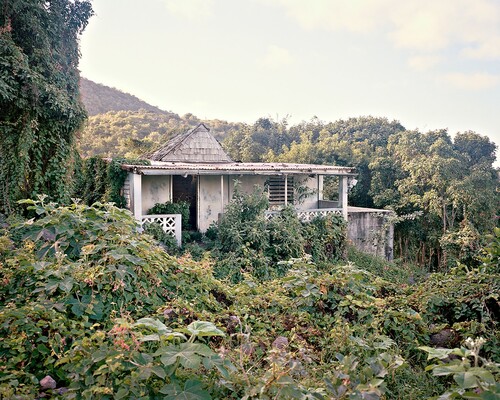
There are just so many things that can be said about chattel in terms of the concept of home and it being portable. Whether it is through the immigration experience itself in terms of what it is that you decide to take with you to a new place and what it is that you leave behind. The decision to say ‘alright let’s just throw it in a suitcase’ can speak to some of the motivations you have for leaving in the first place. At this point in time, I think that most of us have friends where their families arrived as refugees or were fleeing a situation where it was not their conscious choice to leave. Those circumstances in themselves will shape what it is that someone chooses to take with them. My mom came to Canada from England as an au pair and my grandmother came to England as part of the Windrush generation. These choices seem rather luxurious compared to someone who is fleeing for their life because of war. Particularly in being able to have time to choose almost talisman-type objects of what is evocative of ‘home’ for oneself and then getting to bring that with you wherever you are going.
When you are taking the photos, how are you taking them? Are you taking them as you walk through spaces, just moving about your day-to-day, or are you consciously going out to take them?
My process involves all of those elements. A lot of them are taken in the early morning times because that would be when I would go on walks with my father. We would choose different areas, but then as it progressed there were definitely spots that I would return to on subsequent trips. What I thought was interesting was that I eventually would take multiple images in the exact same spots. Some had better results than others. Most of the time I got a much more interesting image the first time than by returning to it.
Do you think the return makes it become romanticised in some way?
Right, exactly, because the thing that I readily admit is that there is a degree of that. I am sentimental about this place. It’s a way of reconciling what it is that’s fixed and trapped in my mind versus the actual reality of being there. A lot of the people in the images are families or relatives that have always lived in proximity to my own. So that is how they appear photographically. In a way they are incidental to the landscape. I was not seeking them out necessarily.
How do you relate the body of work to the larger archive of landscape images of the Caribbean?
The project treads a line between the vernacular and the everyday and the constructions of the formal landscape. The nature of the images is not exactly picturesque. It doesn’t fit within the canon of typical images of the Caribbean that depict pristine beaches and palm trees, or wild seductive nature. This kind of imagery has its own mythology. For the people who live in this landscape, what I’m photographing is mundane and quotidian. Just as our home environments are so familiar to the point that we no longer ‘see’ them. I occupy a very strange space — in that I am the Other and so find meaning in this meaninglessness. The landscape perpetually keeps you at arm’s length — it pushes you back because it doesn’t know you. But you deeply feel that you know it. All of these spaces are taught to me through stories and family lore.
Conceptions of movement and the ‘home-space’ often imply a two-way or multiple trajectory. You have just talked about taking things with you to create a home somewhere else but then the complex experience of returning. How you represent the nothingness or the emptiness or the void in a photographic image seems to be central to the Chattel series, but so does the concept of homesteading.
Completely and also my gaps in that knowledge itself because I have been taught a particular version of that home. So it is sort of like I have been given someone else’s interpretation and then I have formed – using that as my baseline – another interpretation through constantly going back to visit and how that shifts. The authenticity of that experience is complex.
Patricia Seed has an amazing book, Ceremonies of Possession in Europe’s Conquest of the New World 1492–1640, about the different European nations that came and conquered the New World and she really breaks down the techniques of each culture. Like say with the Spaniards, they had a proclamation system that can trace its roots to the declaring of fatwas in Muslim societies. They would read from a document that legally (in accordance with Spanish law) would allow them to engage with the indigenous population as they pleased. This declaration was in a language that the indigenous population would not have understood and its reading did not require people to actually be present. It was merely a formality that had to be performed.
FIGURE 3. STACEY TYRELL, ‘CORN DOG’S HOUSE’, FROM THE CHATTEL SERIES, 2011, C-PRINT. COURTESY THE ARTIST.
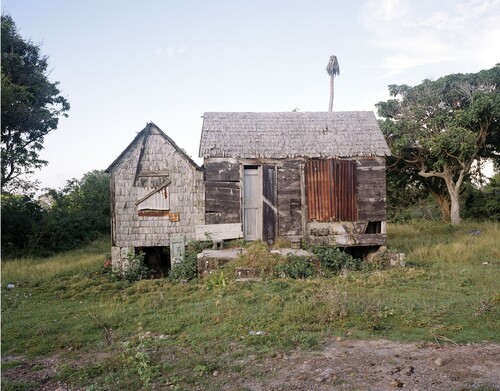
But what I wanted to mention is that in the case of the British they did not require proclamations. They basically viewed the land as a sort of Terra Nullis (nobody’s land) and therefore showed ownership by homesteading. Specifically, with the placement of fences, structures, and farms. It’s interesting to me that the eventual manifestation of the chattel house as a predominant piece of architecture finds itself on the islands colonised by Britain.
In thinking about home-spaces and border-spaces as contested sites, how do you see the project relating to your other works, particularly the Backra Bluid series?
Looking over all of it, there is definitely a progression from experiencing physical space visually to the self-portrait work that I started doing a few years ago which explores inner space. On a cellular level it is all connected to identity. The home-space can be a little strange to navigate because as a second-generation Canadian I was raised with the term ‘home’ meaning the Caribbean. In terms of my genetic make-up, which is what I am exploring with the Backra series, I have African ancestry but I am also partly descended from the Europeans who settled that home. I have a sister who currently lives in Edinburgh, Scotland. From what has been said in my family there were people from there that we are descended from who eventually came to Nevis as planters but I do not necessarily feel that Scotland is partly my home. It’s more of a curiosity. To add another layer, I have lived in the United States for fifteen years and technically I should call it my home. But generally for myself when I refer to ‘back home’ I am usually referring to Canada because it doesn’t feel 100 per cent genuine to refer to Nevis as home. It’s a weird psychological space to occupy.
Right now, if I had to draw a common thread it is that it is not only about the formation of one’s identity but also what one chooses to draw from when you and your family are the products of postcolonial societies. The irony has to do with commonality, the fact that in this part of the world we are all descended from the same groups of people on the other side of the ocean.
Several images show Scottish-produced machinery for refining industrial sugar cane. How do these images fit into the overall series and your broader practice?
The machinery images and the Backra Bluid series are in some ways connected. There is a certain privilege to identifying with a Scottish ancestry — connection to a Celtic origin can be used as a form of cultural capital. In fact, in the Caribbean, this Scottish heritage is embedded in the landscape. The remnants of the machinery that are left behind from the sugar industry can be found throughout Nevis. The names of their origins – Glasgow and Edinburgh – are marked clearly on their surfaces. This photograph () was taken at The Old Manor House, on the Dunbar Estate, which operated as a working sugar plantation until 1936. When it was then active as a hotel property in the 1980s, these remnants were turned into centrepieces or garden features for the enjoyment of hotel guests: one advert boasts: ‘Thanks to its construction around an abandoned sugar mill, this plantation-style inn evokes the aura of a long-gone way of life better than any of its competitors.’ A veneer of banality is placed on this landscape through the saccharine language used in advertising literature from its touristic heyday, with the histories and multiple interactions with the space superficially hidden, or reframed, to those who enter it from outside.
I wondered about the separate images, how you think narrative plays out in them, or whether that emptiness that we were speaking about – the sense of void or meaninglessness – is more important?
I think it functions as both. Some of the spaces are spaces that I knew intimately when I was a lot younger that are now completely vacant and hollowed out or they simply do not exist anymore. And then with others, it really is just about that sense of vacancy. You have these buildings where, because humans used to inhabit and maintain them, nature and the environment were kept at bay, but then when they are no longer occupied the land takes it back. In tropical climates nature is so aggressive that within about a year vegetation and animals take over completely.
In a photo of my mother as a young girl she is standing beside the chattel house – balanced on huge rocks – where she grew up. Later there is a picture of my sister and myself as infants with my great-grandfather in front of it. The rocks had been replaced with cinder blocks and a more modern foundation. Once people no longer occupied the house, goats and other animals started living in it and vines completely took it over. Recently, construction workers for the government who were building a new road in front of it covered it in dirt and debris. We told the government to remove it and their solution was to remove the house. It felt odd to witness this happen to a structure whose initial design intention was to be a portable structure but was very much a familial home for generations. Now when I visit Nevis and go to see it there is just a pile of dirt and rubble that has a small shack remaining. It’s crazy because the physicality of it, to look at it, becomes devoid of meaning. The only thing that sort of embeds meaning back into it now is the fact that other relatives and myself have the memory and experience of occupying it.
Does each individual image have a title?
I have given some of the images titles but others do not have them. A lot of the ones that have titles are drawn from their location or what I was talking to my father about at the time (‘this used to be a church’ or ‘this is a parking lot that looks like a field’). I think visually there is an anonymity with a lot of the images because I wanted a sense that this could be anywhere in the Caribbean. Myself and others, who have a familiarity with Nevis, will recognise places right away but I think there is a beauty in the anonymity.
‘The Bather’ () – one of the few images that includes a person – shows your mother in a swimming cap. How are you figuring the relationship between gender and home-spaces?
I think that is an interesting question, because for me I mainly think of the concept of home as being gender neutral and rooted in place. Obviously there is emotion as well attached to it but both of my parents had full-time and part-time jobs. So there was a lot of time where my mum wasn’t home because of the shift she was working. Interestingly enough my father was the one who taught me a lot of the domestic things that people usually equate with mother’s teaching them. My dad enjoyed these things and he is the one who taught me how to sew and how to cook as well as how to ride a bike. One thing that sticks out is that I remember him saying to my sister and myself ‘you two are little girls and you need to learn these types of things’ but he also taught us how to use tools. Both my parents encouraged us. My father was a lot older than my mother so he had a different perspective at times. For me it depends on which stage of my life I was experiencing ‘home’. If it’s as a child I equate it with a more male energy and from a teen on I equate it with a more female energy.
This way of thinking also potentially disrupts thinking about tropical spaces as ‘feminine’.
Exactly. Nations in general are usually seen as feminine and tropical climates with their heat, natural beauty, and fertile soil are no exception. But then you have this dichotomy of a machismo element to society that functions alongside the matriarchal nature of a lot of Caribbean families. A lot of the time the structure of the family is very different than the concept of the twentieth-century North American nuclear family. It’s a society that very much has its traditional gender roles entrenched and re-enforced, but women are definitely dominant in many other ways. I think that is what happens in more rural environments where everyone of all ages and genders has to pitch in. Everyone has to feed the animals, everyone has to till the soil and tend to crops or you would not eat.
There has been a widespread turn in discourses surrounding the Caribbean towards issues of ecology. Animals feature frequently within the series in relation to their habitats. I wondered if this adds another level to the idea of home-making?
The animals feature because they are unavoidable in what tends to be a more rural landscape. In urban environments we have the extreme of this dynamic of humans imposing themselves and their needs. In Nevis you live alongside animals, as they work to reintegrate into their natural habitat. In the case of structures that are no longer occupied, it doesn’t take the animals long to wander back into these spaces. This is especially prevalent in landscapes that were damaged by hurricanes and natural phenomena. Specifically, with this picture () the building in the background is a hotel that was damaged back in the early 1990s and has yet to be redeveloped (I suspect mainly due to the costs involved). Yet again, this is another example: a sugar mill and structural remnants from Scotland lie strewn in the landscape.
The animals also feature because they are evidence of a prior way of life. The movement of machinery, soils, seeds, people, and animals is part of the same system. Beasts of burden that were brought onto the island were replaced by new forms of technology. They are an inevitable by-product that then has to fight to live amongst this landscape that resists them.
What do you think will be the logical evolution of the Chattel series?
I’m probably just going to continue making the series indefinitely, so long as I can keep returning to Nevis. The process of taking the images is a type of visual therapy or evidence collation because I’m continuously having to re-examine my connection to the space. But it’s also one of those strange things, because the older I get, the more fragmented my connections become. After a while it then gets handed on to me to hold on and pass on the stories and keep the relations going. One day I hope to develop the photographs into a book project because it lends itself to that format. After thirteen years of developing the Chattel series, I have a huge body of images and the process of finding meaning within their form is ongoing.
FIGURE 4. STACEY TYRELL, ‘MARA, 17 YRS.’, FROM THE BACKRA BLUID SERIES, 2011, C-PRINT. COURTESY THE ARTIST.
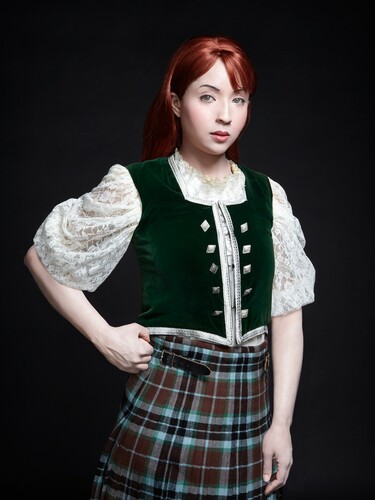
FIGURE 5. STACEY TYRELL, ‘SUGAR PRODUCTION MACHINERY’, FROM THE CHATTEL SERIES, 2010. COURTESY THE ARTIST.
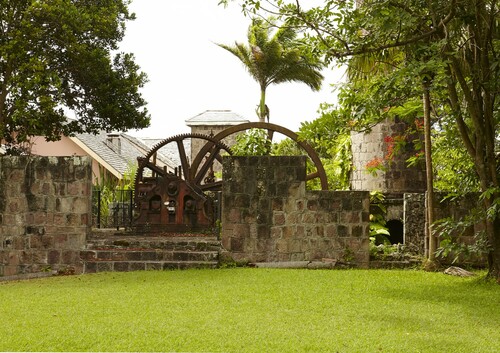
FIGURE 7. STACEY TYRELL, ‘REMNANTS OF CHARLES RILEY NISBET’S IN HERMITAGE ROAD, NEVIS, AFTER GOVERNMENT BULLDOZERS MADE WAY FOR ROAD CONSTRUCTION’, 2018, DIGITAL PHOTOGRAPH. COURTESY THE ARTIST.
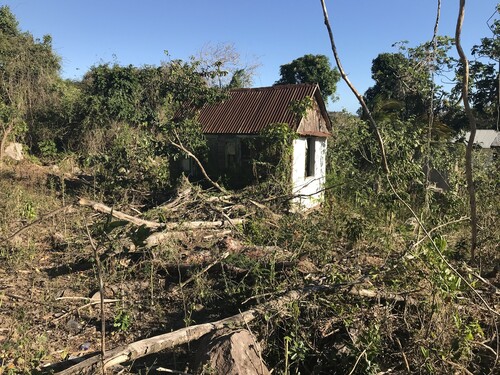
DISCLOSURE STATEMENT
No potential conflict of interest was reported by the author(s).
Notes
1 The term ‘backra’ is a Caribbean slang term of West African origin meaning white master or white person, and ‘bluid’ is a Scottish word for the blood of animals.
2 Tyrell also considers the power of discourses of whiteness within the beauty industry through the photography of skin bleaching or lightening products in the series Great White Hope (2011).
WORK CITED
- Seed, Patricia. Ceremonies of Possession in Europe’s Conquest of the New World 1492–1640. Cambridge UP, 1995.

